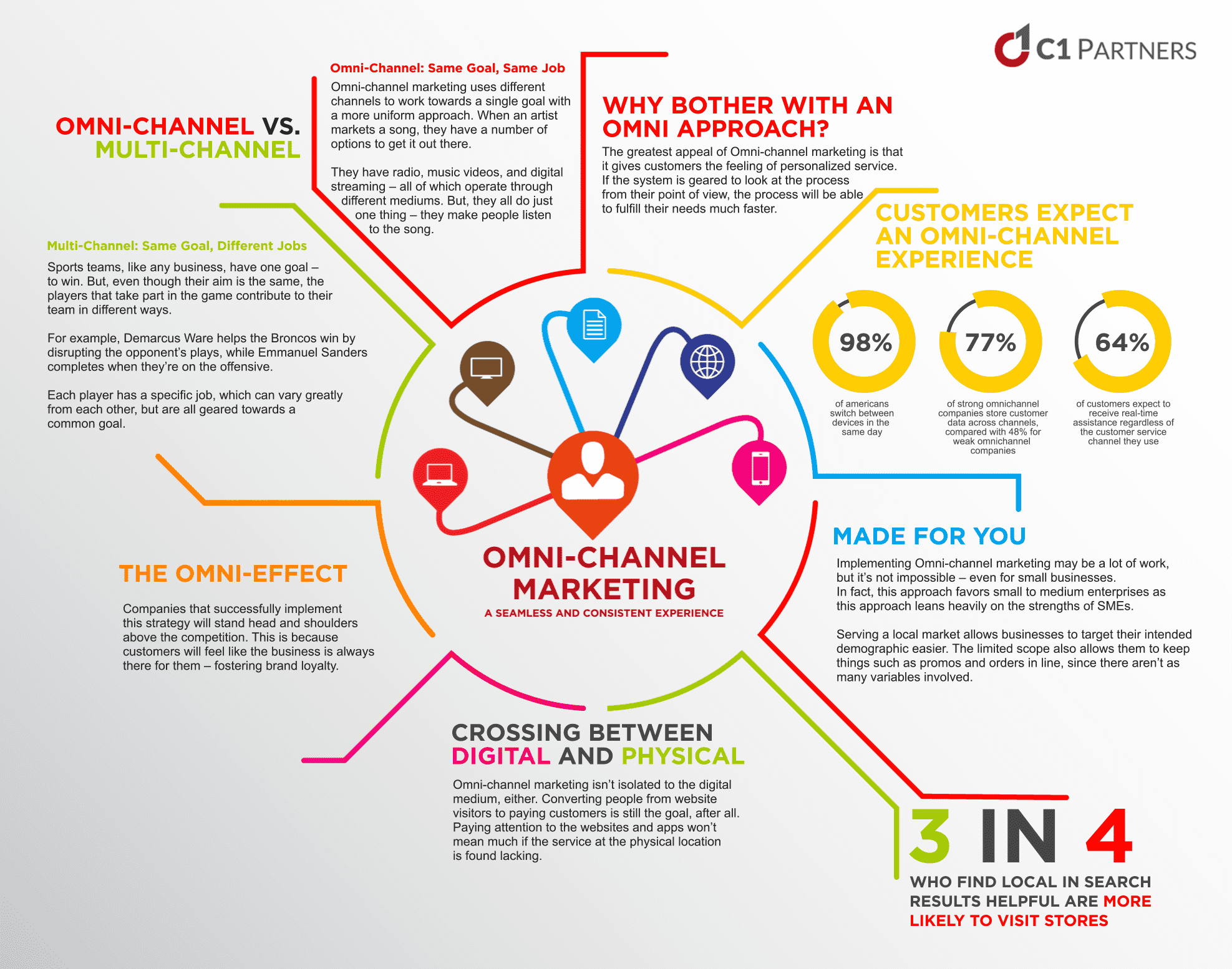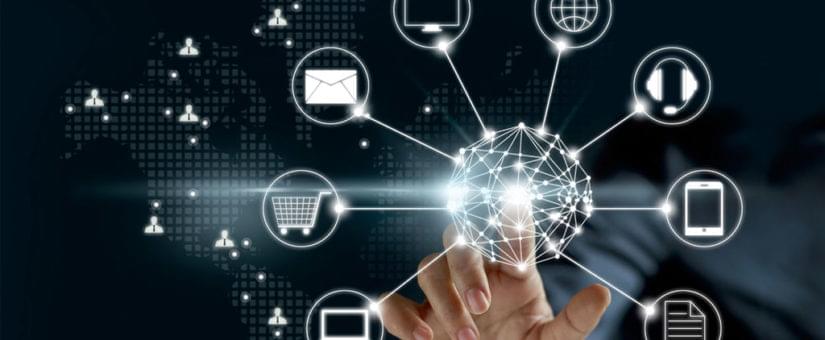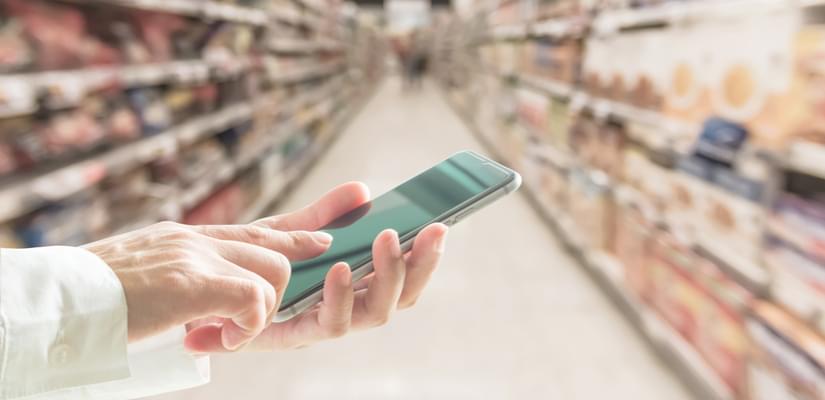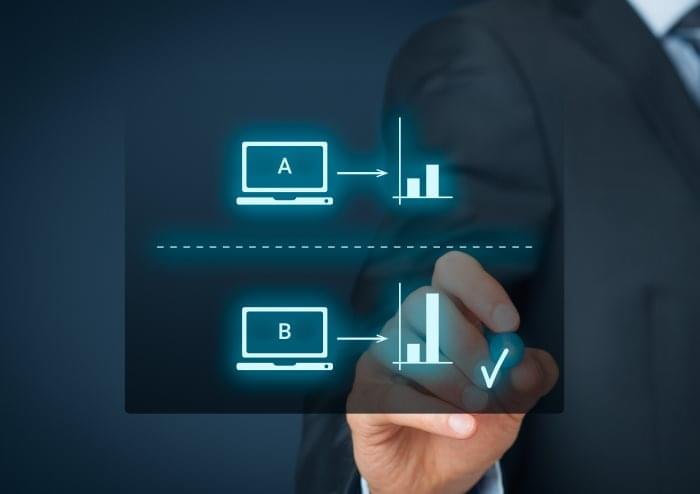Multichannel vs. Omnichannel Marketing
Before we dive into omnichannel marketing, we need to quickly break down multichannel marketing. Omnichannel marketing is a form of multichannel marketing, but multichannel marketing is not the equivalent of omnichannel marketing.Multichannel Marketing
Multichannel marketing, like we said, is a way businesses open themselves up to new audiences, whether it’s through a blog, a website, on the phone, through email, or in person. Because there are so many channels businesses can use to give themselves the best chance at acquiring new customers. Unfortunately, having all these channels doesn’t mean you’re giving your customer the most seamless experience.Omnichannel Marketing
This is where omnichannel marketing comes into play. Omnichannel marketing uses all those same channels, but in a way that best fits the customer’s needs. Some stores like Home Depot show customers where each product is located in the store, so customers can use their phone to navigate through the store instead of being forced to ask for help from a representative who might not even know the answer. So what’s happening is that customers are taking advantage of multiple channels simultaneously and in the way that best fits their needs to ultimately decide if the product is right for them. With simple, multichannel marketing, your business an offer a product online, but it doesn’t necessarily mean the customer can go to a brick-and-mortar store and see the product for themselves, if that’s what they’d want.Integrated Marketing vs. Omnichannel Marketing
Another form of marketing that we also have to touch upon is integrated marketing and how it compares and differs from omnichannel marketing. As we've already mentioned, omnichannel marketing is a form of multichannel marketing. Integrated marketing also has some subtle, but significant differences.
Integrated Marketing
Integrated marketing is a strategy used by marketers that aims to communicate with leads, opportunities, and previous customers by seamlessly integrating ads, sales promotions, public relations, social media, and direct marketing together. Marketers do this to ensure every mode of communication is consistent across multiple channels and are focused primarily on the customer.
Omnichannel Marketing
Again, omnichannel marketing is about blending different channels together that are used to improve the customer experience and buyer's journey. This can mean using an app when you're in line at Dunkin' Donuts to purchase your morning cup of coffee; it can also mean using the target app to receive online coupons and confirm purchases in the store.
As you can see, the difference is subtle, but it is there. Integrated marketing focuses on the strategies marketers use to target leads, opportunities, and customers, while omnichannel marketing focuses primarily on the customer experience and buyer's journey by integrating communication channels between the customer and your business.
Omnichannel Marketing vs. Integrated Marketing vs. Multichannel Marketing
Here's a brief recap of every marketing strategy we've mentioned so far:
| Omnichannel Marketing | Multichannel Marketing | Integrated Marketing | |
| Main Idea | Make communication channels seamless between business and lead/opportunity/customer | Offer leads/opportunities/customers different channels to communicate | Make marketing strategies seamless with each other (ads, sales promotions, public relations, social media, direct marketing) |
| Benefits | More personalized and dynamic customer experiences | Offers different ways for leads to reach out to businesses | Lets marketers send ads tied to promotions on social media so customers don't just get an ad or promotion |
| Example | Using an app to pay for a product in store | Using either a phone, app, or email to do business | Using a character in a commercial across multiple marketing channels (giving the character a social media page, putting him/her on a billboard, designing clothes) |
| Real Life Application | Starbucks app offers promotions and an alternate way of paying | Car dealership creates a TV and radio commercial, but the two aren't connected to each other | Share a Coke, Geico gecko |
There are tons of channels customers can use to come in contact with your business. Here are some of the channels your business should already be using, and why each channel is important for your business’ success. We’ll then provide examples of how each channel works in an omnichannel marketing strategy.
Why Each Channel Matters
1. Phone
Smartphones contain multichannels for people to stay in touch with each other. What makes the smartphone unique is that you can be on the phone while you check your email, or you can listen to music while you’re getting directions. This is a great metaphor for how omnichannel marketing works. The point, though, is that businesses need to make sure their marketing strategies are created with the understanding that people will be using their smartphone to communicate. This means that messages are not just huge walls of text, but are broken up and can be read easily and quickly; this means that pictures and headlines are scalable so your message is clear.An Omnichannel Example: A customer is looking at a product through a company's app, but they have questions or concerns about the product i that need the expertise of a support agent. To help resolve this issue without the customer having to go to the store in person, they can tap a call button on the app and speak to an agent immediately.
2. Email
There are still a good number of holdouts who don’t have a smartphone, but just about everyone has an email address. Reaching out to customers via email in today’s economy is an absolute essential for an omnichannel marketing strategy. The reason it’s so important is because of how accessible it is. Anyone with a computer or smartphone can check their email, and we all know how often we look at our email. The problem with email is that everyone is aware of what spam is, and we’re all bothered by so many people trying to sell us stuff we don’t need; however, there are ways around this issue.An Omnichannel Example: A retail giant like Target can offer customers coupons online that can be sent to the customer’s phone via text and email. All the customer would have to do is show the cashier their phone, which would then be scanned in order to receive the discount. All of this can be done while the customer is walking through the aisles, too.
3. Social Media
There are over two billion active users on Facebook, and hundreds of millions of active users on Twitter, Instagram, and LinkedIn. It goes without saying that the potential to bring in new customers is endless. Social media is a versatile tool businesses can use to reach out to people that are on their phones, at work, or at home on their computer or tablet. Businesses are using social media to connect to customers on a more personal level, creating video ads that are much more targeted based on likes, who they follow, etc.An Omnichannel Example: Businesses use social media to promote certain products. Many small businesses do giveaways where they require people to like the post, follow the page, and share the post with others. In the posts, there are links to the website where people can get more info about the product, and then either buy it online or go to the store if there is one. Social media can also be used for customer support by reaching out to customers who voice their opinions online where everyone they know can see what they're saying.
4. Face-to-Face
Business is definitely changing, where there’s no longer a need for a brick-and-mortar store where customers can go talk to someone face-to-face, but having the option, depending, of course, on what kind of business you’re running, can make a huge difference for customers. There’s simply no need to worry about being personal enough like there is with reaching out to people through email, social media, and websites. When you’re with a customer face-to-face, you can give them immediate answers; you can give them explanations that simplify whatever research they’ve done.An Omnichannel Example: A customer goes into a store looking for a specific product, but it can't be found. Instead of going home empty-handed, they can go to customer service where an agent can take out an iPad and look to see if other stores in the area have that exact product.
5. Website
If your business doesn’t have a website by now, there are bigger issues than omnichannel marketing to worry about. Websites are absolutely essential for businesses today. There’s a whole online market looking to make purchases from the comfort of their couches. The website can offer important contact information like a phone number, email address, and store hours, which all help create an omnichannel atmosphere. What I mean is that a website is only one channel within a multichannel system; however, with the amount of potential channels it can advertise, it becomes an omnichannel option in and of itself. An omnichannel within an omnichannel. Omnichannel-ception.An Omnichannel Example: Small businesses can take advantage of advertising online to help mitigate the lack of customers going in and out of the store. A business can advertise a sale to those who print a coupon that can only be found online. The customer, who didn’t even think to go to the store, would now feel obligated to go in, where sales reps could assist them and even recommend additional purchases.
6. Print Mediums
Yes, this is still a viable option. It’s old school, but it’s reliable. There are people that like to have a catalogue, business card, or report that spells out exactly what a business does. It’s easy to delete an email, but throwing out any of these requires some effort. In an omnichannel setting, print mediums can play a very important role in your business’ marketing campaign. It can help bring customers into the store or help refer them to your website that they never would have known about prior to the business cards you left at another store people constantly visit.An Omnichannel Example: Someone sees a flyer on their car coming home from work. On the flyer, there’s a picture of shoes they’ve been meaning to buy, but they can only be purchased online. At the bottom of the flyer, there’s an email address, phone number, and website URL. The person just coming home from work now has three potential ways of making a purchase or finding out more information.
Why Omnichannel Marketing is Trending
Sometimes it’s just better to let the numbers do the talking. Having a multichannel marketing strategy is pretty essential now, but what will make your business stand out from others is having those channels work fluidly together. These statistics will help explain why omnichannel marketing is trending right now.- 87% of customers think brands need to put more effort into providing a seamless experience.
- Businesses that adopt omnichannel strategies achieve 91% greater year-over-year customer retention rates compared to business that don’t.
- 98% of Americans switch between devices in the same day.
- Today consumers use an average of almost six touch-points with nearly 50% regularly using more than four.
- By 2020, the demand for an omnichannel customer experience will be amplified by the need for nearly perfect execution.
- 90% of customers expect consistent interactions across channels.
- 71% of shoppers who use smartphones for research in-store say that it’s become an important part of the experience.
- Companies with extremely strong omnichannel customer engagement see a 9.5% year-over-year increase in annual revenue, compared to 3.4% for weak omnichannel companies. Similarly, strong omnichannel companies see a 7.5% year-over-year decrease in cost per contact, compared to a 0.2% year-over-year decrease for weak companies.
- 45% of shoppers in-store expect sales associates to be knowledgeable about online-only products.
- 50% of shoppers expect that they will be able to make a purchase online and pick up in-store.
- 89% of customers get frustrated having to repeat their issues to multiple representatives.
- 61% of customers have not been able to easily switch from one channel to another when interacting with customer service.
- 55% of companies have no cross-channel strategy in place.
- 64% of marketers cite lack of resources and investment as their top barrier to omnichannel marketing.
- 27% of consumers would be very likely to leave and visit another retailer’s store if a product is out of stock with 21% stating they would buy online from a different retailer and 21% who would simply hold off buying the product.
Real-world Examples
Finally, we'll get into some real-world examples of businesses that employ omnichannel marketing strategies. These should all be familiar to you. It's not just a coincidence businesses do things the way they do. Let's break down what's actually happening with these companies.Disney
When visitors book a trip online, they can use Disney’s website plan out their daily schedules, use the app to access park information, or even discover new attractions. All of this also connects to their Magic Band program, which allows users to load all of their park tickets, fast pass, and even money to purchase food or souvenirs into a “magic band” that visitors actually wear around their wrists throughout the day. The app, in turn, can also track everything on the band.
Apple Stores
Every Apple Store you've ever been to is filled with employees armed with iPads and iPhones to make purchases, check if products are in stock, schedule support appointments, finalize purchases from anywhere in the store, and send receipts via email so the chance of losing it is minimized. From the moment you walk into an Apple Store to the moment you leave, an agent is ready to assist with a variety of channels that best fit your needs.
Starbucks
Starbucks is another great example thanks to their app. The app showcases what new drinks are available, while also giving customers the option to build a drink order beforehand. That eliminates the need to wait in line and make a last second decision on what to actually get because the amount of drinks Starbucks offers is endless. It also offers customers another way to pay for their drinks by allowing them to upload their credit card info and gift cards.
Disney, Apple, and Starbucks in one section. This section is goals for every basic teenage girl in America, but they're all quite useful for explaining what omnichannel marketing is and how they're used in the real world; it's not just limited to big corporations. These strategies can be implemented in businesses of all sizes.



